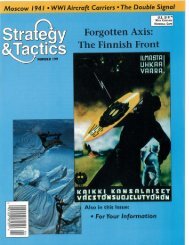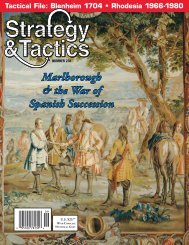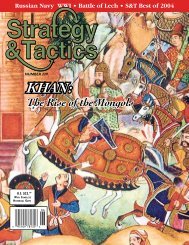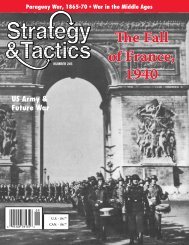COUNTERSTROKE AT SOLTSY - Strategy & Tactics Press
COUNTERSTROKE AT SOLTSY - Strategy & Tactics Press
COUNTERSTROKE AT SOLTSY - Strategy & Tactics Press
You also want an ePaper? Increase the reach of your titles
YUMPU automatically turns print PDFs into web optimized ePapers that Google loves.
7 – Takeo: Japanese engineer battalion.<br />
8 – Battambang: Malaysian infantry battalion, Thai engineer<br />
battalion, Pakistani logistics company, Australian<br />
signals company and air transport group, multi-national<br />
mine clearance training unit.<br />
9 East – Kampong Speu: Bulgarian infantry battalion.<br />
9 West – Kampong Chnang: Tunisian infantry battalion,<br />
Malaysian air transport group.<br />
Phnom Penh: Ghana and Indonesian infantry battalions,<br />
German medical battalion, Australian signals battalion,<br />
French air transport group, Uruguayan naval patrol.<br />
Most of those contingents were composite forces rather<br />
than standing formations. Forty New Zealanders served<br />
with the Australian communications unit. There was also a<br />
multi-national MP company with a maximum strength of<br />
217, including 20 Australians.<br />
Notable Events<br />
On 26 February 1992 an Australian soldier was wounded<br />
when his helicopter took ground fire in the Kompong<br />
Thom area.<br />
April 1993 was the most dangerous month for UN military<br />
personnel, with seven fatalities and 15 injured. Three<br />
separate incidents around Kampong Speu left four<br />
Bulgarians dead and nine wounded. One Japanese UN<br />
employee and his interpreter also died.<br />
During early May 1993, a Japanese policeman was killed<br />
and 13 UN personnel were injured.<br />
On May 20 1993, a rocket fired during factional fighting<br />
missed its target and killed two UN observers in the<br />
Chinese engineer compound in Kampong Cham.<br />
On 27 July 1993, an Australian soldier on guard at UNTAC<br />
headquarters in Phnom Penh killed a Cambodian policeman<br />
after he fired at a criminal suspect fleeing past the<br />
building.<br />
In August 1993, an Australian soldier was forced to<br />
smash his radio before fleeing from a Khmer Rouge attack<br />
with his mixed nationality team. The team was rescued by<br />
Thai soldiers and returned to their base unharmed. That<br />
same month, the commander of the Australian contingent,<br />
Lt. Col. Russell Stuart, faced charges after his service pistol<br />
was stolen along with his vehicle. And Chinese troops were<br />
forced to wear differently patterned uniforms because the<br />
Khmer Rouge were extensively supplied with standard<br />
green Chinese uniforms and weapons. A German army<br />
medic was shot dead in a motorcycle drive-by in Phnom<br />
Pehn. After the trouble experienced during the repatriation<br />
homeward of the first 400 Bulgarians, Australian military<br />
police escorted the second flight home.<br />
A total of 41 military personnel became casualties, as<br />
well as four observers and 14 civilian police.<br />
operation Gemini<br />
Australia’s military involvement in UNTAC reached its<br />
peak strength of 600 during the elections, winding down<br />
to 150 by the time UNTAC disbanded. There were also<br />
substantial contributions to the civilian police and election<br />
forces. Australia also provided the initial military commander,<br />
Lt Gen. John Sanderson, who retired in October<br />
1992.<br />
—Peter Schutze<br />
the Long tradition:<br />
50 issues ago, S&t 182:<br />
Balkans 1941. Joseph Miranda drives in<br />
with a simulation of the Wehrmacht’s 1941<br />
blitzkrieg against Yugoslavia and Greece.<br />
Veteran gamer Maj. Donald Mack marches<br />
into the Sudan with “Chinese” Gordon<br />
and the Khartoum campaign, while David<br />
Nicholas takes to the barricades with the<br />
Freikorps. Pierre Corbeil, Charles Plummer<br />
and Jay Schindler go Beyond Wargaming<br />
with an analysis of the simulation game as<br />
a professional tool. And Anthony Howarth<br />
closes out with a look at unit cohesion during<br />
the wars of religion.<br />
100 issues ago, S&t 132:<br />
iron Cross.Tactical level combat in World<br />
War II, brought to you by Mark Sprock<br />
and Allyn Vannoy. Thomas Kane updates<br />
everyone on the fighting in Beirut, and Al<br />
Nofi goes to historical extremes with pieces<br />
on both the gladiators and the proliferation<br />
of weapons in the modern world.<br />
150 issues ago, S&t 82:<br />
fifth Corps. This was something of a<br />
modern warfare issue, with Fifth Corps, a<br />
grand tactical simulation of the US Army<br />
versus the Soviets in a “what if” World War<br />
III. Design credits include the prolific Jim<br />
Dunnigan, the solid John Butterfield and<br />
the artistic Redmond Simonsen. Elsewhere<br />
in the issue, Col. Trevor Dupuy (yes, that<br />
Col. Dupuy!) analyzes the Suez battles in<br />
the 1973 Arab-Israeli War, and Charles<br />
T. Kamps covers N<strong>AT</strong>O’s Central Front.<br />
Rounding out the issue and keeping readers<br />
up to date are Briefings and FYI.<br />
200 issues ago, S&t 32:<br />
napoleon at War. John Young uses the<br />
Napoleon at Waterloo system to wargame<br />
the Battle of Borodino, where the Grande<br />
Armee took on the Russians on the road to<br />
Moscow in one of the biggest bloodbaths<br />
of the Napoleonic era. The game puts the<br />
slightly superior French against the entrenched<br />
Russians in a contest that is often<br />
not decided until the last roll of the die.<br />
Issue articles include Al Nofi’s Napoleon<br />
at War and Lenny Glynn and Dave Isby<br />
on Pershing in the Great War. Plus Pass in<br />
Review and Sid Sackson on games.<br />
strategy & tactics 37







